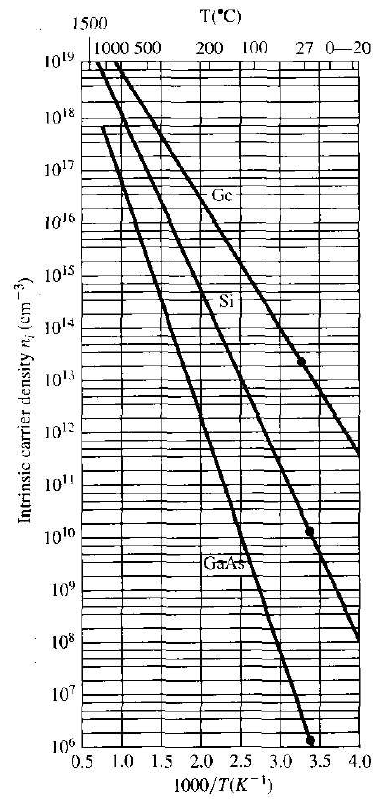
The Intrinsic Carrier Concentration
 المؤلف:
Donald A. Neamen
المؤلف:
Donald A. Neamen
 المصدر:
Semiconductor Physics and Devices
المصدر:
Semiconductor Physics and Devices
 الجزء والصفحة:
p 110
الجزء والصفحة:
p 110
 17-5-2017
17-5-2017
 4385
4385
The Intrinsic Carrier Concentration
For an intrinsic semiconductor, the concentration of electrons in the conduction band is equal to the concentration of holes in the valence band. We may denote ni and pi as the electron and hole concentrations, respectively, in the intrinsic semiconductor. These parameters are usually referred to as the intrinsic electron concentration and intrinsic hole concentration. However, ni = pi, so normally we simply use the parameter ni as the intrinsic carrier concentration, which refers to either the intrinsic electron or hole concentration.
The Fermi energy level for the intrinsic semiconductor is called the intrinsic Fermi energy, or EF = EFi. Then we can write
 (1)
(1)
and
 (2)
(2)
If we take the product of Equations (1) and (2), we obtain
 (3)
(3)
or
 (4)
(4)
where Eg is the bandgap energy. For a given semiconductor material at a constant temperature, the value of ni is a constant, and independent of the Fermi energy.
The intrinsic carrier concentration for silicon at T = 300 K may be calculated by using the effective density of states function values from Table 1.1. The value of ni calculated from Equation (4) for Eg = 1.12 eV is ni = 6.95 × 109 cm-3. The commonly accepted value of ni for silicon at T = 300 K is approximately 1.5 × 1010 cm-3. This discrepancy may arise from several sources. First, the values of the effective masses are determined at a low temperature where the cyclotron resonance experiments are performed. Since the effective mass is an experimentally determined parameter, and since the effective mass is a measure of how well a particle moves in a crystal, this parameter may be a slight function of temperature. Next, the density of states function for a semiconductor was obtained by generalizing the model of an electron in a three-dimensional infinite potential well. This theoretical function may also not agree exactly with experiment. However, the difference between the theoretical value and the experimental value of ni is approximately a factor
Table 1.1 Effective density of states function and effective mass values

Table 1.2 Commonly accepted value of ni at T = 300K.

of 2, which, in many cases, is not significant. Table 1.2 lists the commonly accepted values of ni for silicon, gallium arsenide, and germanium at T = 300 K.
The intrinsic carrier concentration is a very strong function of temperature. Figure 1.1 is a plot of ni from Equation (4) for silicon, gallium arsenide, and germanium as a function of temperature. As seen in the figure, the value of ni for these semiconductors may easily vary over several orders of magnitude as the temperature changes over a reasonable range.

Figure 1.1 The intrinsic carrier concentration of Ge, Si, and GaAs as a function of temperature.
 الاكثر قراءة في أشباه الموصلات
الاكثر قراءة في أشباه الموصلات
 اخر الاخبار
اخر الاخبار
اخبار العتبة العباسية المقدسة


